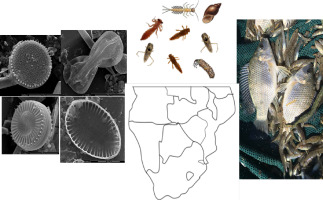Science of the Total Environment ( IF 9.8 ) Pub Date : 2018-08-21 , DOI: 10.1016/j.scitotenv.2018.08.252 Tinotenda Mangadze , Tatenda Dalu , P. William Froneman

|
Biological monitoring programmes have gained popularity around the world particularly in southern Africa as they are fast, integrative and cost-effective approaches for assessing the effects of environmental stressors on aquatic ecosystems. This article reviews current efforts that have been made to use bioindicators (i.e. macroinvertebrates, diatoms and fish) in monitoring water resources and to summarise the challenges in employing these biological monitoring tools in southern Africa. In South Africa, macroinvertebrate (South African Scoring System (SASS)) and diatom based indices (e.g. South African diatom index (SADI)) have demonstrated their utility in identifying sources of impairment and determining the extent of impacts thus giving natural resource managers a scientifically defensible rationale for developing guidelines for conservation and management. Despite this advancement in South Africa, however, developing regionally appropriate quantitative tools for diagnosing ecosystem health is a pressing need for several other southern African countries. Together with sound scientific research, it is imperative for southern African countries to develop specific legislation and have mandated agencies, with proper training and funding to implement biomonitoring and bioassessments. We recommend for the advancement and adoption of biological criteria as an integrated approach to assessing the impact of human activities in riverine ecosystems of the southern African region.
中文翻译:

南部非洲的生物监测:现状,挑战和未来前景回顾
生物监测计划已迅速在世界范围内流行,特别是在南部非洲,因为它们是评估环境压力因素对水生生态系统影响的快速,综合和具有成本效益的方法。本文回顾了目前在使用生物指示剂(即大型无脊椎动物,硅藻)方面所做的努力。和鱼类)来监测水资源,并总结在南部非洲使用这些生物监测工具所面临的挑战。在南非,大型无脊椎动物(南非评分系统(SASS))和基于硅藻的指数(例如,南非硅藻指数(SADI))已证明其在识别损害来源和确定影响程度方面的效用,从而为自然资源管理者提供了科学依据制定保护和管理指南的合理理由。尽管南非取得了进步,但是,仍在开发适合本地区诊断的定量工具生态系统健康是南部非洲其他几个国家的紧迫需求。加上良好的科学研究,南部非洲国家必须制定具体的立法并授权机构,并接受适当的培训和资金以实施生物监测和生物评估。我们建议提高和采用生物学标准,作为评估人类活动对南部非洲区域河流生态系统影响的综合方法。


























 京公网安备 11010802027423号
京公网安备 11010802027423号